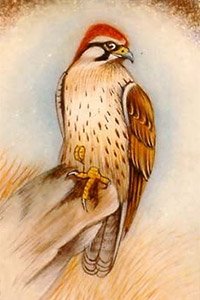Shyainikashastra, Śyainikaśāstra, Shyainika-shastra: 3 definitions
Introduction:
Shyainikashastra means something in Hinduism, Sanskrit. If you want to know the exact meaning, history, etymology or English translation of this term then check out the descriptions on this page. Add your comment or reference to a book if you want to contribute to this summary article.
The Sanskrit term Śyainikaśāstra can be transliterated into English as Syainikasastra or Shyainikashastra, using the IAST transliteration scheme (?).
In Hinduism
Ayurveda (science of life)
Source: Cracow Indological Studies: Virūpākṣa-vasantotsava-campū of AhobalaŚyainikaśāstra (श्यैनिकशास्त्र) is the name of a Sanskrit treatise dealing with the divisions and benefits of hunting written by Rājā Rudradeva of Kumaon (16 th century CE?).—In Kauṭilya’s Arthaśāstra hunting is mentioned among addictions or vices (vyasana) of the human race. According to Rudradeva hunting literally provides medicine which can be a remedy for childless men: “By the eating of the wholesome meat of wild boar and buffaloes bagged in hunting, sexual desire and capacity are increased, which leads to the enjoyment of women by the increase of strength”.

Āyurveda (आयुर्वेद, ayurveda) is a branch of Indian science dealing with medicine, herbalism, taxology, anatomy, surgery, alchemy and related topics. Traditional practice of Āyurveda in ancient India dates back to at least the first millenium BC. Literature is commonly written in Sanskrit using various poetic metres.
Shyanika-shastra (the science of Hawking and Hunting)
Source: archive.org: Syainika Sastra of Rudradeva with English TranslationŚyainikaśāstra (श्यैनिकशास्त्र) is a book on hawking in Sanskrit by Rudradeva (or Candradeva or Rudracandra Deva as the MS. C calls him), a Rājā of Kūrmācala or Kumaon.—[Summary]: (1) The first chapter is devoted to the defence of what Paṇḍitas would call “vices’; and the defence is eminently practical. These should be indulged in for the enjoyment of life. But none should be wholly given up to them. (2) In the second chapter these “vices” are enumerated and defined. The last of the vices is mṛgayā or hunting. (3) In the third chapter various kinds of hunting are enumerated and defined, the last of which is śyenapāta or hawking. (4) In the fourth chapter various kinds of hawks are enumerated and described. Their training and their capacity for hunting birds and beasts are also described there in great detail. (5) The fifth chapter is devoted to the kind and quantity of their food, their tending in different seasons, and the treatment of their diseases. (6) In the sixth, various methods of sport with these birds are described ; and, in accdrdance with the time-honoured custom of Indian Paṇḍitas, the enjoyment of the eight different rasas or emotions can be derived from the sport of hawking. (7) In the seventh are the after-enjoyments of the sport.

Shyanika-shastra (श्यैनिकशास्त्र, śyainikaśāstra) deals with ancient Indian skill of hawking/falconry (one of the ways of hunting) which were laid down in a systematic manner in various Sanskrit treatises. It also explains the philosophy behind how the pleasures derived from sense-experience could lead the way to liberation.
Languages of India and abroad
Sanskrit dictionary
Source: DDSA: The practical Sanskrit-English dictionaryŚyainikaśāstra (श्यैनिकशास्त्र).—The science of hunting; Gīrvāṇa.
Derivable forms: śyainikaśāstram (श्यैनिकशास्त्रम्).
Sanskrit, also spelled संस्कृतम् (saṃskṛtam), is an ancient language of India commonly seen as the grandmother of the Indo-European language family (even English!). Closely allied with Prakrit and Pali, Sanskrit is more exhaustive in both grammar and terms and has the most extensive collection of literature in the world, greatly surpassing its sister-languages Greek and Latin.
See also (Relevant definitions)
Partial matches: Shyainika, Shastra.
Full-text (+1346): Shyainika, Candradeva, Rudracandradeva, Pakshakakalika, Culanka, Prithaglakshana, Rudradeva, Anusara, Marga, Pada, Padamarga, Kuta, Matta, Rasa, Sama, Sukumara, Uparodhana, Ashvasadin, Vishama, Javadhika.
Relevant text
Search found 1 books and stories containing Shyainikashastra, Shyainika-shastra, Śyainika-śāstra, Syainika-sastra, Śyainikaśāstra, Syainikasastra; (plurals include: Shyainikashastras, shastras, śāstras, sastras, Śyainikaśāstras, Syainikasastras). You can also click to the full overview containing English textual excerpts. Below are direct links for the most relevant articles:
Amarakoshodghatana of Kshirasvamin (study) (by A. Yamuna Devi)
Pastimes and Games < [Chapter 3 - Social Aspects]